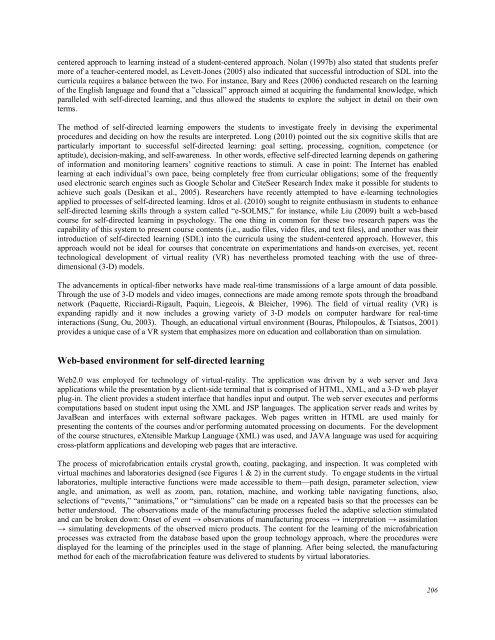Development of a Web-based System to Support Self-Directed ...
Development of a Web-based System to Support Self-Directed ...
Development of a Web-based System to Support Self-Directed ...
Create successful ePaper yourself
Turn your PDF publications into a flip-book with our unique Google optimized e-Paper software.
centered approach <strong>to</strong> learning instead <strong>of</strong> a student-centered approach. Nolan (1997b) also stated that students prefer<br />
more <strong>of</strong> a teacher-centered model, as Levett-Jones (2005) also indicated that successful introduction <strong>of</strong> SDL in<strong>to</strong> the<br />
curricula requires a balance between the two. For instance, Bary and Rees (2006) conducted research on the learning<br />
<strong>of</strong> the English language and found that a ”classical” approach aimed at acquiring the fundamental knowledge, which<br />
paralleled with self-directed learning, and thus allowed the students <strong>to</strong> explore the subject in detail on their own<br />
terms.<br />
The method <strong>of</strong> self-directed learning empowers the students <strong>to</strong> investigate freely in devising the experimental<br />
procedures and deciding on how the results are interpreted. Long (2010) pointed out the six cognitive skills that are<br />
particularly important <strong>to</strong> successful self-directed learning: goal setting, processing, cognition, competence (or<br />
aptitude), decision-making, and self-awareness. In other words, effective self-directed learning depends on gathering<br />
<strong>of</strong> information and moni<strong>to</strong>ring learners’ cognitive reactions <strong>to</strong> stimuli. A case in point: The Internet has enabled<br />
learning at each individual’s own pace, being completely free from curricular obligations; some <strong>of</strong> the frequently<br />
used electronic search engines such as Google Scholar and CiteSeer Research Index make it possible for students <strong>to</strong><br />
achieve such goals (Desikan et al., 2005). Researchers have recently attempted <strong>to</strong> have e-learning technologies<br />
applied <strong>to</strong> processes <strong>of</strong> self-directed learning. Idros et al. (2010) sought <strong>to</strong> reignite enthusiasm in students <strong>to</strong> enhance<br />
self-directed learning skills through a system called “e-SOLMS,” for instance, while Liu (2009) built a web-<strong>based</strong><br />
course for self-directed learning in psychology. The one thing in common for these two research papers was the<br />
capability <strong>of</strong> this system <strong>to</strong> present course contents (i.e., audio files, video files, and text files), and another was their<br />
introduction <strong>of</strong> self-directed learning (SDL) in<strong>to</strong> the curricula using the student-centered approach. However, this<br />
approach would not be ideal for courses that concentrate on experimentations and hands-on exercises, yet, recent<br />
technological development <strong>of</strong> virtual reality (VR) has nevertheless promoted teaching with the use <strong>of</strong> threedimensional<br />
(3-D) models.<br />
The advancements in optical-fiber networks have made real-time transmissions <strong>of</strong> a large amount <strong>of</strong> data possible.<br />
Through the use <strong>of</strong> 3-D models and video images, connections are made among remote spots through the broadband<br />
network (Paquette, Ricciardi-Rigault, Paquin, Liegeois, & Bleicher, 1996). The field <strong>of</strong> virtual reality (VR) is<br />
expanding rapidly and it now includes a growing variety <strong>of</strong> 3-D models on computer hardware for real-time<br />
interactions (Sung, Ou, 2003). Though, an educational virtual environment (Bouras, Philopoulos, & Tsiatsos, 2001)<br />
provides a unique case <strong>of</strong> a VR system that emphasizes more on education and collaboration than on simulation.<br />
<strong>Web</strong>-<strong>based</strong> environment for self-directed learning<br />
<strong>Web</strong>2.0 was employed for technology <strong>of</strong> virtual-reality. The application was driven by a web server and Java<br />
applications while the presentation by a client-side terminal that is comprised <strong>of</strong> HTML, XML, and a 3-D web player<br />
plug-in. The client provides a student interface that handles input and output. The web server executes and performs<br />
computations <strong>based</strong> on student input using the XML and JSP languages. The application server reads and writes by<br />
JavaBean and interfaces with external s<strong>of</strong>tware packages. <strong>Web</strong> pages written in HTML are used mainly for<br />
presenting the contents <strong>of</strong> the courses and/or performing au<strong>to</strong>mated processing on documents. For the development<br />
<strong>of</strong> the course structures, eXtensible Markup Language (XML) was used, and JAVA language was used for acquiring<br />
cross-platform applications and developing web pages that are interactive.<br />
The process <strong>of</strong> micr<strong>of</strong>abrication entails crystal growth, coating, packaging, and inspection. It was completed with<br />
virtual machines and labora<strong>to</strong>ries designed (see Figures 1 & 2) in the current study. To engage students in the virtual<br />
labora<strong>to</strong>ries, multiple interactive functions were made accessible <strong>to</strong> them—path design, parameter selection, view<br />
angle, and animation, as well as zoom, pan, rotation, machine, and working table navigating functions, also,<br />
selections <strong>of</strong> “events,” “animations,” or “simulations” can be made on a repeated basis so that the processes can be<br />
better unders<strong>to</strong>od. The observations made <strong>of</strong> the manufacturing processes fueled the adaptive selection stimulated<br />
and can be broken down: Onset <strong>of</strong> event → observations <strong>of</strong> manufacturing process → interpretation → assimilation<br />
→ simulating developments <strong>of</strong> the observed micro products. The content for the learning <strong>of</strong> the micr<strong>of</strong>abrication<br />
processes was extracted from the database <strong>based</strong> upon the group technology approach, where the procedures were<br />
displayed for the learning <strong>of</strong> the principles used in the stage <strong>of</strong> planning. After being selected, the manufacturing<br />
method for each <strong>of</strong> the micr<strong>of</strong>abrication feature was delivered <strong>to</strong> students by virtual labora<strong>to</strong>ries.<br />
206
















